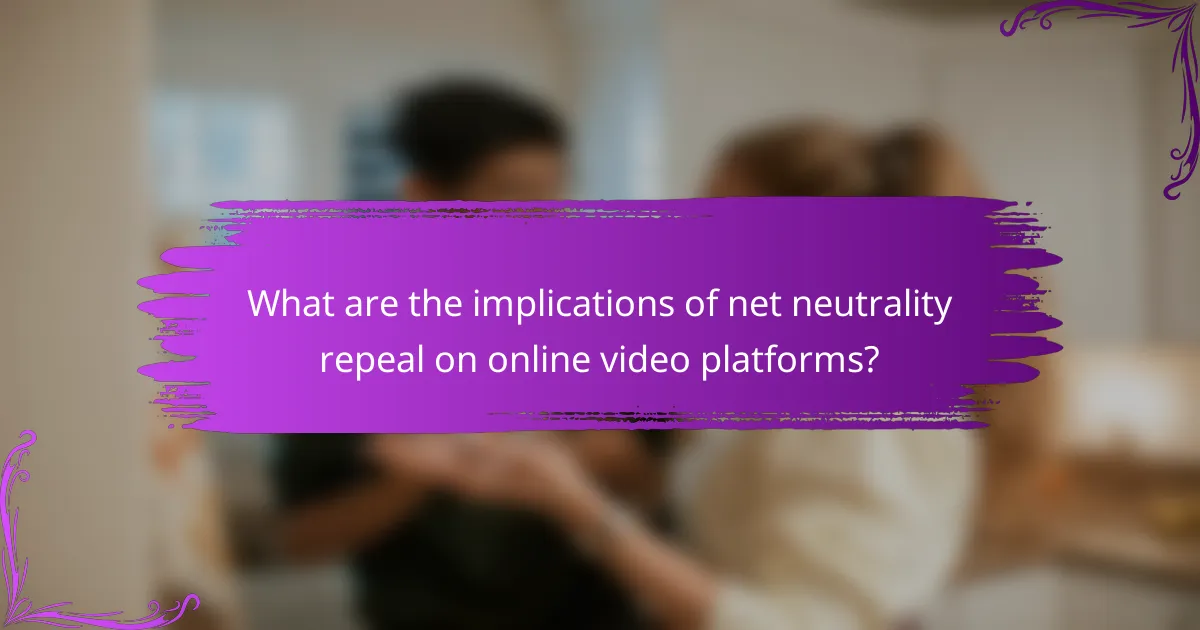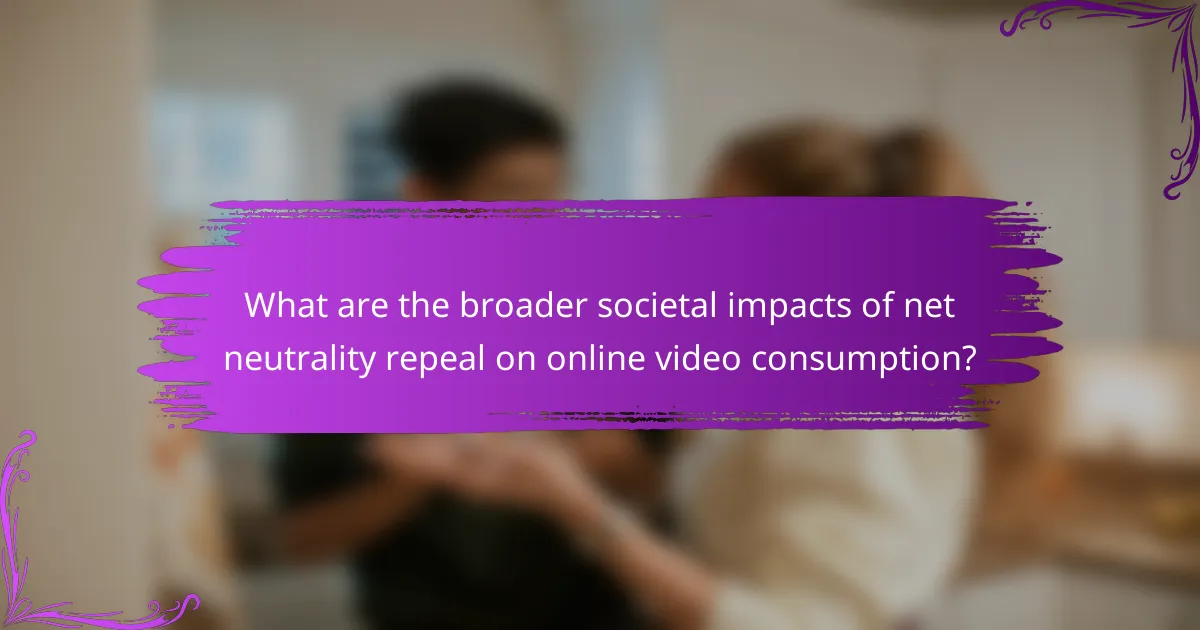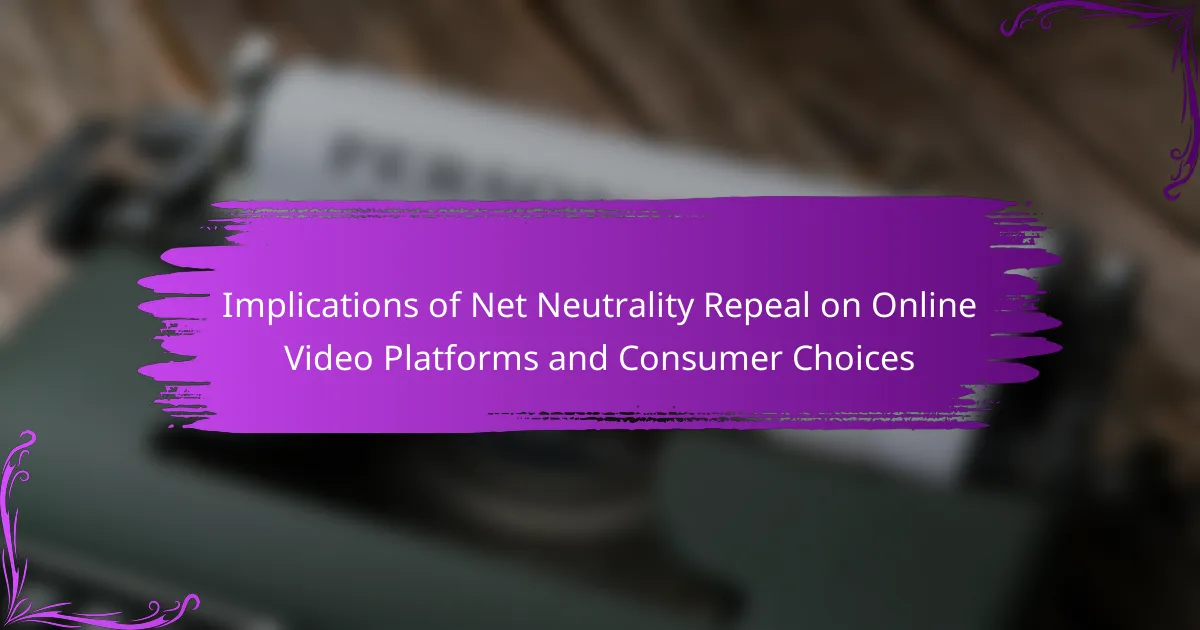
What are the implications of net neutrality repeal on online video platforms?
The repeal of net neutrality affects online video platforms by allowing internet service providers (ISPs) to prioritize certain content. ISPs can create “fast lanes” for preferred services, potentially disadvantaging competitors. This may lead to increased costs for consumers and smaller platforms. Consumers might face higher subscription fees or reduced access to diverse content. Additionally, the quality of streaming could vary based on ISP agreements. Research indicates that without net neutrality, innovation in video services may decline as startups struggle to compete. The implications extend to user choice, as dominant platforms could monopolize viewer attention.
How does net neutrality affect the operation of online video platforms?
Net neutrality ensures that all internet traffic is treated equally. This principle affects online video platforms by preventing internet service providers (ISPs) from prioritizing certain content. Without net neutrality, ISPs could create fast and slow lanes for video streaming services. This would lead to higher costs for consumers and potentially limit access to smaller platforms. Research indicates that in countries without net neutrality, video platform diversity decreases. A 2017 report by the Open Technology Institute showed that net neutrality protections encourage innovation and competition among video services. Thus, net neutrality plays a crucial role in maintaining a level playing field for online video platforms.
What are the key principles of net neutrality relevant to video streaming?
The key principles of net neutrality relevant to video streaming include equal treatment of all data and prevention of discriminatory practices. Net neutrality mandates that Internet Service Providers (ISPs) cannot prioritize or throttle specific video streaming services. This principle ensures that all users have equal access to content regardless of the source. It prevents ISPs from creating “fast lanes” for certain services, which could disadvantage smaller platforms. The Federal Communications Commission (FCC) established these principles to promote competition and innovation. In 2015, the FCC classified broadband as a telecommunications service, reinforcing net neutrality rules. The repeal of these rules in 2017 raised concerns about potential biases against certain video streaming platforms. This could lead to a fragmented experience for consumers, affecting their choices in video content.
In what ways do video platforms rely on net neutrality for content delivery?
Video platforms rely on net neutrality to ensure equal access to content delivery. Net neutrality prevents internet service providers from prioritizing certain content over others. This allows video platforms to deliver content without interference or throttling. Users can access any video service without facing slow speeds for specific platforms. It supports competition among video platforms by leveling the playing field. Without net neutrality, ISPs could charge platforms for faster delivery, limiting options for consumers. Studies show that net neutrality fosters innovation in video content creation. Overall, net neutrality is essential for maintaining a fair and open internet for video streaming.
What potential changes might occur in consumer choices after the repeal?
After the repeal of net neutrality, consumer choices may shift significantly. Consumers might gravitate towards platforms that offer prioritized service for a fee. This could lead to increased subscription costs for premium access. Additionally, users may experience slower speeds on non-paying platforms. As a result, some consumers might opt for fewer services due to cost concerns. Data from the Pew Research Center indicates that 73% of Americans value internet equality. Therefore, changes in consumer behavior may reflect a preference for platforms that ensure equitable access. Overall, the repeal could reshape how consumers prioritize service quality and cost in their choices.
How could the repeal influence subscription models for consumers?
The repeal of net neutrality could lead to increased costs for consumers using subscription models. Without net neutrality, internet service providers may prioritize certain services over others. This could result in higher fees for consumers to access specific platforms. Additionally, consumers might face tiered subscription models based on bandwidth usage or service priority. Historical data shows that in markets without net neutrality, prices often rise due to reduced competition. This scenario could limit consumer choices and increase overall expenses for accessing online video platforms.
What impact might the repeal have on the availability of diverse content?
The repeal of net neutrality may significantly reduce the availability of diverse content. Without net neutrality, internet service providers can prioritize certain content. This could lead to a tiered internet where only major platforms receive adequate bandwidth. Smaller or niche content providers might struggle to compete. As a result, consumers may face limited choices in content. Historical examples show that similar regulations have led to reduced diversity in media offerings. The 2017 repeal of net neutrality in the U.S. raised concerns about potential monopolistic practices. Studies indicate that diverse content thrives in a neutral internet environment.

What are the potential consequences for consumers and content creators?
The potential consequences for consumers and content creators include reduced access to content and increased costs. Consumers may face higher subscription fees as internet service providers prioritize certain platforms. This could lead to limited choices and slower access to competing services. Content creators may struggle to reach audiences if their platforms are deprioritized. They might also incur additional costs to ensure visibility on major networks. Research indicates that in areas with less competition, prices for internet services tend to rise, impacting consumer affordability. The repeal of net neutrality could fundamentally change the landscape of online video platforms and consumer options.
How might consumer access to video content change?
Consumer access to video content may change significantly due to the repeal of net neutrality. Without net neutrality, internet service providers can prioritize certain content. This could lead to faster access for paid content while slowing down or throttling access to competing services. Consumers may face higher costs as providers create tiered service models. This shift could limit choices, forcing consumers to subscribe to multiple services. Additionally, smaller video platforms may struggle to compete. Research indicates that net neutrality plays a crucial role in maintaining a level playing field for all content providers. Therefore, the repeal could reshape the landscape of online video consumption.
What are the risks of increased costs for consumers?
Increased costs for consumers can lead to reduced access to essential services. Higher prices may force consumers to prioritize spending on necessities. This could limit their ability to afford diverse online video content. Consequently, consumers might experience a decrease in choices and quality of service. Studies show that when costs rise, consumer engagement often declines. For example, a report by the Federal Communications Commission indicated that reduced competition leads to higher prices. This trend can negatively impact consumer satisfaction and overall market health.
How could throttling affect user experience on video platforms?
Throttling negatively impacts user experience on video platforms by reducing streaming quality. Users may experience buffering, lower resolution, and longer load times. This leads to frustration and decreased engagement with content. According to a study by the University of California, throttling can increase buffering time by up to 50%. Additionally, throttling can limit access to high-definition content, which is increasingly expected by viewers. Overall, throttling diminishes the overall satisfaction with video services, driving users to seek alternative platforms.
What challenges do content creators face in a post-net neutrality landscape?
Content creators face significant challenges in a post-net neutrality landscape. They may encounter increased costs for hosting and delivering content. Internet service providers (ISPs) can prioritize certain content over others, leading to unequal visibility. This can limit the reach of smaller creators who cannot afford premium service tiers. Additionally, creators may experience slower loading times for their content if they do not pay for faster delivery. This can impact viewer engagement and retention rates. The lack of net neutrality can also lead to a fragmented internet experience, making it harder for creators to build and maintain audiences. Overall, these challenges can hinder creativity and innovation in content creation.
How might the repeal affect content distribution and visibility?
The repeal of net neutrality may significantly impact content distribution and visibility. Without net neutrality, internet service providers (ISPs) can prioritize certain content over others. This could lead to faster loading times for preferred content while slowing down or blocking access to competing services. Consequently, smaller content creators may struggle to reach audiences effectively. Studies show that prioritization can lead to a significant disparity in visibility. For example, research by the Open Technology Institute indicates that 76% of consumers believe that net neutrality is essential for a fair internet. The absence of these regulations may create a tiered internet experience, favoring larger companies with more resources.
What strategies can content creators adopt to navigate these changes?
Content creators can adopt several strategies to navigate changes resulting from the repeal of net neutrality. They should diversify their platforms to reduce reliance on a single service. This approach mitigates risks associated with potential throttling or prioritization by specific providers. Creators can also engage directly with their audience through newsletters and social media. Building a loyal community ensures consistent support regardless of platform changes.
Additionally, content creators should invest in SEO and discoverability strategies. This will enhance their visibility across different platforms, helping them reach audiences even if certain services become less accessible. Collaborations with other creators can also expand reach and share audiences.
Finally, monitoring industry trends and changes in regulations is crucial. Staying informed allows creators to adapt quickly to new policies or shifts in consumer behavior. These strategies collectively empower content creators to maintain their presence and influence in a changing digital landscape.

What are the broader societal impacts of net neutrality repeal on online video consumption?
The repeal of net neutrality has significant societal impacts on online video consumption. It creates a tiered internet where access to video content may depend on payment. Consumers could face higher costs for premium streaming services. This may limit access for lower-income individuals and communities. Content providers may prioritize faster delivery for those who pay more. Independent creators could struggle to compete with established platforms. This could lead to reduced diversity in available video content. Overall, the repeal threatens equitable access to online video. It risks creating a digital divide based on economic status.
How does net neutrality repeal affect competition among video platforms?
The repeal of net neutrality negatively affects competition among video platforms. Without net neutrality, Internet Service Providers (ISPs) can prioritize certain video services over others. This creates an uneven playing field where larger platforms may receive faster speeds and better access. Smaller or new video platforms could struggle to compete under such conditions. ISPs may also impose additional fees on platforms for better service, increasing costs for consumers. Research indicates that reduced competition can lead to higher prices and fewer choices for consumers. As a result, the overall diversity of video content may diminish in the market.
What role does competition play in content innovation and diversity?
Competition drives content innovation and diversity by encouraging creators to differentiate their offerings. It fosters an environment where unique perspectives and formats emerge. For instance, diverse content attracts various audience segments, enhancing viewer engagement. Research shows that platforms with multiple competitors often see a rise in creative content strategies. According to a 2021 study by the Pew Research Center, increased competition leads to a broader range of genres and themes in online video. This dynamic ultimately enriches the consumer experience, providing more choices and fostering a vibrant content ecosystem.
How might a lack of competition impact consumer choices?
A lack of competition can lead to reduced consumer choices. When few companies dominate a market, they may limit the variety of products available. This can result in higher prices due to reduced price competition. Consumers may also experience lower quality services as companies face less pressure to improve. For instance, research shows that monopolistic markets often lead to stagnant innovation. According to a study by the Federal Trade Commission, reduced competition can hinder technological advancements. Consequently, consumers may find themselves with fewer options and diminished satisfaction.
What steps can consumers take to protect their interests?
Consumers can protect their interests by staying informed about net neutrality issues. They should regularly review their internet service agreements. This helps them understand any changes in service quality or pricing. Consumers can also advocate for net neutrality legislation. Joining consumer advocacy groups can amplify their voices. Monitoring internet service performance is crucial. They should report any discrepancies to regulatory bodies. Engaging with online platforms about their practices fosters accountability. Finally, exploring alternative service providers can ensure better options.
What are effective ways for consumers to advocate for net neutrality?
Consumers can advocate for net neutrality by participating in public comments during regulatory proceedings. The Federal Communications Commission (FCC) allows consumers to submit their opinions on proposed regulations. Engaging in social media campaigns can also raise awareness and mobilize support. Organizations like Fight for the Future provide resources for effective online activism.
Additionally, contacting elected representatives can influence policy decisions. Consumers can share their concerns about net neutrality through emails, phone calls, or in-person meetings. Educating others about the implications of net neutrality helps build a stronger advocacy community.
Supporting organizations that promote net neutrality can amplify consumer voices. Donations or volunteer work for these groups can further the cause. These methods collectively empower consumers to impact net neutrality policies effectively.
How can consumers stay informed about changes in video platform policies?
Consumers can stay informed about changes in video platform policies by regularly checking official announcements from the platforms. Many video platforms provide updates through their websites or blogs. Subscribing to newsletters from these platforms can also deliver policy changes directly to consumers’ inboxes. Following social media accounts of video platforms allows consumers to receive real-time updates. Additionally, industry news websites often report on significant policy changes affecting video platforms. Engaging in online forums or communities can provide insights from other users about policy updates. Monitoring regulatory bodies’ websites can also inform consumers about broader industry changes related to net neutrality.
The main entity of this article is the implications of net neutrality repeal on online video platforms and consumer choices. The article examines how the repeal allows internet service providers (ISPs) to prioritize certain content, potentially disadvantaging smaller platforms and increasing costs for consumers. It discusses the operational effects on video platforms, the potential changes in consumer choices and subscription models, and the broader societal impacts, including reduced access to diverse content and challenges faced by content creators. Key principles of net neutrality are highlighted, along with strategies for consumers and creators to navigate the evolving landscape of online video consumption.



